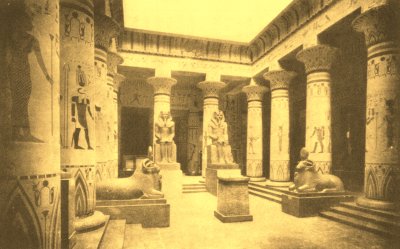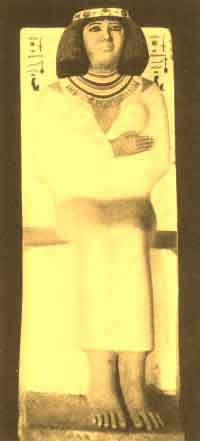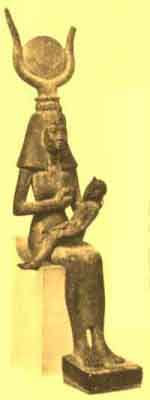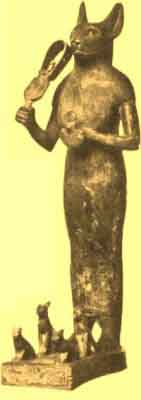Egyptian Myth and Legend Chapter 26, The Religious Revolt of the Poet King
EGYPTIAN MYTH AND LEGEND
With Historical Narrative, Notes on Race Problems, Comparative Beliefs, etc.
by
Donald Mackenzie
Gresham Publishing Co., London
[1907]
CHAPTER XXVI
The Religious Revolt of the Poet King
The Shelley of Egypt--King as a Prophet--The Need of the Empire--Disturbing Race Movements--Fall of Cretan Kingdom--Hittites press Southward--Khabri advance on Palestine--Akhenaton's War on Amon--The New Capital--A Poet's Dream--Empire going to Ruin--Aton the "First Cause"--A Grand Theology--Origin of the New Deity--Shu in the Sun--The Soul in the Egg--The Air of Life--A Jealous God--The Future Life--Paradise or Transmigration of Souls--Death of Akhenaton--Close of a Brilliant Dynasty.
HERODOTUS was informed by the sages of Egypt that the Souls of the dead passed through "every species of terrestrial, aquatic, and winged creatures", and, after a lapse of about three thousand years, "entered a second time into human bodies". If that belief were as prevalent at present in these islands as it was in early Celtic times, we might be at pains to convince the world that Shelley was a reincarnation of Akhenaton. The English poet was born about 3150 years after the death of Egypt's "heretic King", and both men had much in common; they were idealists and reformers at war with the world, and "beautiful but ineffectual angels". With equal force these lines by William Watson may be applied to the one as to the other:--
Impatient of the world's fixed way,
He ne'er could suffer God's delay,
But all the future in a day
Would build divine. . . .
Shelley's reference to himself in "Adonais" is admirably suited for Akhenaton.
Mid others of less note, came one frail form,
A phantom among men; companionless
As the last cloud of an expiring storm,
Whose thunder is its knell; he, as I guess,
Had gazed on Nature's naked loveliness,
Actn-like, and now he fled astray
With feeble steps o'er the world's wilderness.
A pard-like spirit beautiful and swift--
A Love in desolation masked;--a Power
Girt round with weakness; it can scarce uplift
The weight of the superincumbent hour;
It is a dying lamp, a failing shower,
A breaking billow;-even whilst we speak
Is it not broken? . . .
Like Shelley, too, Akhenaton appears to have resolved, while yet a boy, to fight against "the selfish and the strong", whom he identified particularly with the priests of Amon, for these were prone indeed to "tyrannize without reproach and check". The Egyptian prince, like the young English gentleman, began to "heap knowledge from forbidden mines of lore", and "from that secret store wrought linked armour for his soul"; he embraced and developed the theological beliefs of the obscure Aton cult, and set forth to convince an unheeding world that--
The One remains, the many change and pass,
Heaven's light forever shines, Earth's shadows fly.
From the point of view of the Egyptian Imperialists the reign of Akhenaton, like that of Queen Hatshepsut, was a distinct misfortune. As it happened, the dreamer king ascended the throne with the noble desire to make all men "wise, and just, and free, and mild", just when the Empire was in need of another ruler like Thothmes III to conduct strenuous military campaigns against hordes of invaders and accomplish the subjection of the rebellious Syrian princes.

AMENHOTEP II
From the colossal granite bust in the British Museum

AMENHOTEP IV (AKHENATON)
From the statuette in the Louvre, Paris
Once again, as in the Twelfth Dynasty, the civilized world was being disturbed by the outpourings from mountainous districts of pastoral peoples in quest of "fresh woods and pastures new". Crete had been invaded during the reign of Amenhotep III; the "sack of Knossos" was already a thing of the past; the great civilization of the island kingdom had received its extinguishing blow, and thousands of the "Kheftiu" were seeking permanent homes in the ean, Asia Minor, Phnicia, and Egypt. Ere Akhenaton's father had died, Thebes received ominous intelligence of the southward pressure of the Hittites and also of the advance on Palestine of the Khabri (? Hebrews)--the first "wave" of the third great Semitic migration from eastern Arabia, known as the "Aramn". The days of the half-Iranian, half-Egyptian Tushratta were numbered; the civilization of Mitanni was doomed to vanish like that of Crete.
Akhenaton began to reign as Amenhotep IV. With purpose, apparently, to effect the immediate conversion of Thebes, he began the erection of a temple to Aton (or Aten) in close proximity to that of Amon. Ere long an open rupture between the priesthood and the Pharaoh became the chief topic of political interest. Amon's high priests had been wont to occupy high and influential positions at Court; under Amenhotep III one had been chief treasurer and another grand vizier. Akhenaton was threatening the cult with complete political extinction. Then something was done, or attempted to be done, by the priestly party, which roused the ire of the strong-minded young king, for he suddenly commenced to wage a war of bitter persecution against Amon. Everywhere the god's name was chipped from the monuments; the tombs were entered, and the young Pharaoh did not spare even the name of his father. It was at this time that he himself became known officially as Akhen-aton, "the spirit of Aton" 1 --the human incarnation of the strange god. Then he decided to desert Thebes, and at Tell-el-Amarna, about 300 miles farther south, he caused to be laid out a "garden city", in which were built a gorgeous palace which surpassed that of his father, and a great temple dedicated to "the one and only god". Aton temples were also erected in Nubia, near the third cataract, and in Syria at a point which has not beet, located.
When he entered his new capital, which was called "Horizon of Aton", the young king resolved never to leave it again. There, dwelling apart from the unconverted world, and associating with believers only, he dedicated his life to the service of Aton, and the propagation of those beliefs which, he was convinced, would make the world a Paradise if, and when, mankind accepted them.
Meanwhile more and more alarming news poured in from Syria. "Let not the king overlook the killing of a deputy", wrote one subject prince . . . . .. If help does not come, Bikhura will be unable to hold Kumidi." * * * In a later communication the same prince "begs for troops"; but he begged in vain. "If the king does not send troops," he next informed Akhenaton, "all the king's lands, as far as Egypt, will fall into the hands of the Khabri." Another faithful ally wrote: "Let troops be sent, for the king has no longer any territory; the Khabri have wasted all". To this communication was added a footnote addressed to the royal scribe, which reads: "Bring aloud before my lord, the king, the words, 'The whole territory of my lord, the king, is going to ruin'." 2
In the stately temple at Tell-el-Amarna, made beautiful by sculptor and painter, and strewn daily with bright and perfumed flowers, the dreamer king, oblivious to approaching disaster, continued to adore Aton with all the abandon and sustaining faith of a cloistered medieval monk.
"Thou hast made me wise in thy designs and by thy might", he prayed to the god . . . . . "The world is in thy hand."
Akhenaton accounted it sinful to shed blood or to take away the life which Aton gave. No sacrifices were offered up in his temple; the fruits of the earth alone were laid on the altars. He had already beaten the sword into a ploughshare. When his allies and his garrison commanders in Syria appealed for troops, he had little else to send them but a religious poem or a prayer addressed to Aton.
Hard things are often said about Akhenaton. One writer dismisses him as an "thetic trifler", others regard him as "a half-mad king"; but we must recognize that he was a profoundly serious man with a great mission, a high-souled prophet if an impractical Pharaoh. He preached the gospel of culture and universal brotherhood, and his message to mankind is the only vital thing which survives to us in Egypt amidst the relics of the past.
'T is naught
That ages, empires, and religions there
Lie buried in the ravage they have wrought;
For such as he can lend,--they borrow not
Glory from those who made the world their prey;
And he is gathered to the kings of thought
Who waged contention with their time's decay,
And of the past are all that cannot pass away.
He remains to us as one of "the inheritors of unfulfilled renown",
Whose names on earth are dark
But whose transmitted effluence cannot die
So long as fire outlives the parent spark. . . .
He believed in the "one and only god", Aton, whose power was manifested in the beneficent sun; the great deity was Father of all mankind, and provided for their needs and fixed the length of their days. Aton was revealed in beauty, and his worshippers were required to live beautiful lives--the cultured mind abhorred all that was evil, and sought after "the things which are most excellent"; it shrank from the shedding of blood; it promoted the idea of universal brotherhood, and conceived of a beautiful world pervaded by universal peace.
No statues of Aton were ever made; Akhenaton forbade idolatrous customs. Although Aton was a sun god, he was not the material sun; he was the First Cause manifested by the sun, "from which all things came, and from which ever issued forth the life-giving and life-sustaining influence symbolized by rays ending in hands that support and nourish human beings". "No such grand theology had ever appeared in the world before, so far as we know," says Professor Flinders Petrie, "and it is the forerunner of the later monotheist religions, while it is even more abstract and impersonal, and may well rank as scientific theism." 3 The same writer says: "If this were a new religion, invented to satisfy our modern scientific conceptions, we could not find a flaw in the correctness of its view of the energy of the solar system. How much Akhenaton understood we cannot say, but he had certainly bounded forward in his views and symbolism to a position which we cannot logically improve upon at the present day. No rag of superstition or of falsity can be found clinging to this new worship evolved out of the old Aton of Heliopolis, the sole lord or Adon of the Universe". 4
The chief source of our knowledge of Akhenaton's religion is his great hymn, one of the finest surviving versions of which has been found in the tomb of a royal official at Tell-el-Amarna. It was first published by Bouriant, and has since been edited by Breasted, whose version is the recognized standard for all translations. 5
The development of Aton religion may have been advanced by Yuaa, Queen Tiy's father, during the reign of Amenhotep III, when it appears to have been introduced in Court circles, but it reached its ultimate splendour as a result of the philosophical teachings of the young genius Akhenaton. It has its crude beginnings in the mythological beliefs of those nature worshippers of Egypt and other countries who conceived that life and the universe were of male origin. We can trace it back even to the tribal conception that the soul of the world-shaping giant was in the chaos egg. In the Theban Recension of the Book of the Dead Ra is addressed:
O thou art in thine Egg, who shinest from thy Aton.
O thou beautiful being, thou dost renew thyself, and make thyself young again under the form of Aton. . . .
Hail Aton, thou lord of beams of light; thou shinest and all faces (i.e. everybody) live. 6
There was an Aton cult at Heliopolis which taught that the creator Ra was "Shu in his Aton". Aton is the solar disk and Shu is the air god, the source of "the air of life". the Great Father who is the soul of the universe. Like "the Baal", Shu is also associated with the sun; the atmospheric god is manifested by lightning and fire as well as by tempest. Shu is thus not only "air which is in the sun", but also, according to Akhenaton's religion, "heat which is in Aton". In the Tell-el-Amarna poem, Aton, who creates all things, "makest the son to live in the body of his mother". Then follows a reference to "the egg":
When the chick is in the egg and is making a sound within the shell,
Thou givest it air inside it so that it may keep alive.
Budge's trans.
The small bird in the egg, sounding within the shell,
Thou givest to it breath within the egg
To give life to that which thou makest.
Griffith's trans.
When the chicklet crieth in the egg-shell,
Thou givest him breath therein, to preserve him alive. 7
--Breasted's trans.
When Akhenaton and his queen were depicted worshipping Aton, the rays which stretched out from the sun and ended in hands not only supported their bodies but pressed towards their nostrils and lips the "ankh", the "symbol of life". The air of life was the sun-heated air; life was warmth and breath. 8 Why the "ankh" touched the lips is clearly indicated in the great hymn. When the child is born, Aton--
Openest his mouth that he may speak.
Aton was thus, like certain other Egyptian gods, "the opener", 9 who gave power of speech and life to a child at birth or to the mummy of the dead. In this connection Wiedemann says that Ptah "bore a name which is probably derived from the root pth, "to open", especially as used in the ritual term "opening of the mouth". Porphyrius, 10 "who was well informed in Egyptian matters", tells us that the god (Ptah) came forth from an egg which had issued from the mouth of Kneph (a word signifying "air breath", and "spirit Kneph is Khnin his character as an atmosphere god.
Some authorities identify Aton with the old Syrian god Adon. The root "ad" or "dad" signifies "father". As "ad" becomes at "in" Attis it may be that, as a result of habitual phonetic conditions, Adon became Aton. But Akhenaton's Aton was a greater conception than Adon.
The marked difference between the various Egyptian and Asiatic "Great Fathers" and the god of Akhenaton consists in this--Aton was not the chief of a Pantheon: he was the one and only god. "The Aton", says Professor Petrie, "was the only instance of a 'jealous god' in Egypt, and this worship was exclusive of all others, and claims universality." 11 Had Akhenaton's religion been the same as that of the Aton cult at Heliopolis we might expect to find him receiving direct support from that quarter. To the priests of Ra he was as great a "heretic" as he was to the priests of Amon, or Amon-Ra, at Thebes.
Akhenaton's conception of the material universe did not differ from that which generally obtained in. his day in Egypt. There was a Nile in heaven and a Nile in the underworld. In rainless Upper Egypt he believed that--
The Nile in heaven is for the strange people. . . .
Thou (Aton) placest a Nile in heaven that it may rain upon them.
Griffiths.
The Nile of the underworld was "for the land of Egypt".
When thou hast made the Nile beneath the earth
Thou bringest it according to thy will to make the people live. . . .
That it may nourish every field.
Griffiths.
Aton also made the firmament in which to rise:
Rising in thy forms as the living Aton,
Shining afar off and returning . . .
All eyes see thee before them.
Griffiths.
We do not obtain from the hymn any clear idea of Akhenaton's conception of evil. There is no reference to the devil serpent, or to the war waged against the sun god in Heliopolitan myth. But it appears that as light was associated with life, goodness, and beauty, darkness was similarly filled with death and evil. At night men lie down to sleep and "their nostrils are stopped", or "their breath is shut up". Then creatures of evil are abroad; "every lion cometh from his den and serpents of every kind bite" (Budge). Nor is there any reference to the after life. "When thou (Aton) settest in the western horizon the earth is in darkness, and is like a being that is dead" (Budge) or "like the dead" (Breasted and Griffiths). Akhenaton appears to have believed in the immortality of the soul-the bodies of Queen Tiy, his mother, and of his daughter and himself were embalmed--but it is not certain whether he thought that souls passed to Paradise, to which there is no reference in the poem, or passed from egg, or flower, to trees, animals, , until they once again entered human bodies, as in the Anpu-Bata story and others resembling it which survive in the folktales of various ages and various countries.
Akhenaton's hymn to Aton is believed to have been his own composition. Its beauty is indicated in the following extracts from Prof. Breasted's poetic translation:--
When thou risest in the eastern horizon of heaven,
Thou fillest every land with thy beauty.
When thou settest in the western horizon of heaven,
The world is in darkness like the dead.
Bright is the earth when thou risest in the horizon,
When thou shinest as Aton by day.
The darkness is banished, when thou sendest forth thy rays.
How manifold are all thy works,
They are hidden from before us,
O thou sole god, whose powers no other possesseth,
Thou didst create the earth according to thy desire
While thou wast alone.
The world is in thy hand,
Even as thou hast made them.
When thou hast risen, they live.
When thou settest, they die.
For thou art duration, beyond thy mere limbs.
By thee man liveth,
And their eyes look upon thy beauty
Until thou settest.
Thou makest the beauty of form. . . .
Thou art in my heart.
The revolution in art which was inaugurated under Amenhotep III is a marked feature of Akhenaton's reign. When sculptors and painters depicted the king he posed naturally, leaning on his staff with crossed legs, or accompanied by his queen and children. Some of the decorative work at Tell-el-Amarna will stand comparison with the finest productions of to-day.
The records which survive to us of the Akhenaton period are very scanty, for when the priests of the old faith again came to power they were at pains to obliterate them. Queen Tiy does not appear to have taken a prominent part in the new movement, which had developed beyond her expectations; and although she occasionally visited the city of Aton, her preference for Thebes, the scene of her social triumphs, remained to the end. Akhenaton's wife was a queen consort, as Tiy had been, and the royal couple delighted to appear among the people accompanied by their children.
The fall of the Amon party was complete. For several years the eight temples of Amon at Thebes lay empty and silent; their endowments had been confiscated for Aton, to whom new temples were erected in the Fayum and at Memphis, Heliopolis, Hermonthis, and Hermopolis.
An endeavour was made to enforce the worship of Aton by royal decree all over Egypt, with the result that the great mass of the people, who appear to have shown little concern regarding the fall of the tyrannical Amon party, were aroused to oppose with feelings of resentment an uncalled-for interference with the immemorial folk customs and beliefs which were so closely associated with their habits of life. But still the power of the "heretic king" remained supreme. The army remained loyal, although it had shrunk to an insignificant force, and when Akhenaton placed in command Horemheb it appears to have effectively controlled the disturbed areas.
Akhenaton died while still a young man, and left no son to succeed him. Semenkh-ka-ra, who had married a princess, became the next Pharaoh, but he appears to have been deposed by another son-in-law of the "heretic", named Tutenk-aton, who returned to Thebes, allied himself with the priests, and called himself Tutenkamon, "Image of Amon". He was followed in turn by Ai (Eye), who called himself "Divine Father" and then a military revolt, instigated by the priests, brought to the throne, after a brief period of anarchy, Horemheb, who secured his position by marrying a princess of the royal line. He popularized himself with the worshippers of the ancient cults by ruthlessly persecuting the adherents of the religion of Akhenaton, erasing the name of Aton everywhere. He appears to have re-established the power of Egypt over a part of Palestine, and he restored order in the kingdom. So the Eighteenth Dynasty came to an end about two and a half centuries after the expulsion of the Hyksos.
Footnotes
1 Or, "Aton is satisfied" (Sethe).
2 "Tell-el-Amarna Letters" in Professor Flinders Petrie's History of Egypt, Vol. II.
3 The Religion of Egypt, London, 1908.
4 A History of Egypt, Vol. II, London.
5 The most important of these appear in the following publications: Breasted's A History of Egypt, Petrie's A History of Egypt (version by Griffiths), Budge's Gods of the Egyptians, and Wiedemann's Religion of the Ancient Egyptians. In Naville's The Old Egyptian Faith (English translation by Rev. C. Campbell) the view is urged that Akhenaton's religious revolt was political in origin.
6 Budge's Gods of the Egyptians and Book of the Dead.
7 Amon-ra also "giveth breath to that which is in the egg" (Religion of the Ancient Egyptians, Wiedemann, p. 115).
8 A ray of light from the moon gave origin to the Apis bull. See Chapter V.
9 Osiris Sokar is "the opener of the mouth of the four great gods who are in the underworld" (The Burden of Isis, p. 54).
10 Eusebius, Praratio Evangelica, III, 11; Wiedemann, Religion of the Ancient Egyptians.
11 The Religion of Ancient Egypt, p. 54.
- 0
- Published in Egyptian Myth and Legend
- Written by LC Geerts


















